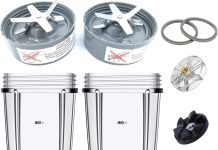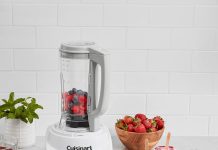In this article, we will explore the key distinctions between countertop blenders and immersion blenders. Have you ever wondered what sets these two kitchen appliances apart? We’ve got you covered! Whether you’re a seasoned cook or just starting out, understanding the unique features and capabilities of these blenders can greatly enhance your culinary adventures. So, grab your favorite smoothie recipe and let’s dive into the wonderful world of countertop and immersion blenders!
Review contents
Size and Design
Countertop Blenders
Countertop blenders are typically larger and bulkier than immersion blenders. They are designed to sit on your kitchen countertop and take up a significant amount of space. Countertop blenders have a base that houses the motor, controls, and blending jar.
Immersion Blenders
On the other hand, immersion blenders are much smaller and more compact. They are handheld devices with a long shaft that contains the motor and blades. Immersion blenders are designed to be immersed directly into the ingredients you are blending, eliminating the need for a separate blending jar.
Functionality
Countertop Blenders
Countertop blenders are incredibly versatile and can handle a wide range of tasks. They can blend, puree, chop, and crush ice with ease. Many countertop blenders also come with additional attachments, such as food processors and smoothie cups, further expanding their functionality.
Immersion Blenders
While not as versatile as their countertop counterparts, immersion blenders excel in certain tasks. They are perfect for blending soups, sauces, and other liquid-based recipes directly in the pot or bowl. Immersion blenders are also great for making small batches of smoothies or whipped cream.
Blending Capacity
Countertop Blenders
Countertop blenders generally have a larger blending capacity compared to immersion blenders. They typically come with a large blending jar, ranging from 40 to 80 ounces, allowing you to make larger batches of food or drinks. This makes countertop blenders a great choice for cooking for a family or hosting parties.
Immersion Blenders
On the other hand, immersion blenders have a smaller blending capacity. The blending shaft is typically around 6 to 10 inches long, limiting the amount of ingredients you can blend at once. While immersion blenders may not be suitable for large-scale blending, they are perfect for smaller servings or individual use.
Power and Speed
Countertop Blenders
Countertop blenders are known for their powerful motors, typically ranging from 500 to 1500 watts. This allows them to crush ice, blend tough ingredients, and create smooth and consistent textures. Countertop blenders also offer multiple speed settings, allowing you to adjust the blending speed according to your recipe’s requirements.
Immersion Blenders
Immersion blenders generally have less power compared to countertop blenders. Their motors typically range from 200 to 500 watts, which is sufficient for blending softer ingredients. However, they may struggle with tougher ingredients, such as ice or frozen fruits. Immersion blenders usually have limited speed options, typically only offering two or three settings.
Versatility
Countertop Blenders
Countertop blenders are incredibly versatile and can handle a wide range of tasks in the kitchen. Besides blending, countertop blenders often come with additional functions such as chopping, pureeing, and even grinding coffee beans. Some high-end countertop blenders also have preset programs for specific recipes, making them even more versatile.
Immersion Blenders
While not as multifunctional as countertop blenders, immersion blenders have their own unique versatility. They excel in blending tasks, especially when it comes to soups, sauces, and small batches of drinks. Immersion blenders are also great for making baby food or quickly blending ingredients directly in a bowl or pot.
Ease of Use
Countertop Blenders
Countertop blenders are generally very straightforward to use. They often have intuitive control panels with buttons or dials for adjusting speed and selecting functions. The blending jar is designed with a secure lid and a pouring spout, making it easy to transfer blended contents. However, the assembly and disassembly of the blending jar and blades may take some time and effort.
Immersion Blenders
Immersion blenders are known for their simplicity and ease of use. They are lightweight and comfortable to hold, allowing for easy maneuverability while blending. Immersion blenders often have a simple on/off switch, as well as a speed control button. This ease of use makes immersion blenders a great choice for quick and hassle-free blending tasks.
Cleaning and Maintenance
Countertop Blenders
Cleaning a countertop blender can be a bit more involved compared to cleaning an immersion blender. Countertop blenders often have a larger blending jar, along with removable blades and seals, which all need to be cleaned separately. Some models are dishwasher-safe, while others require handwashing. Proper maintenance, such as regularly checking and replacing seals and blades, is essential for keeping your countertop blender in optimal condition.
Immersion Blenders
Immersion blenders are relatively easy to clean and maintain. Since the motor and blades are integrated into a single handheld unit, there are no separate parts to worry about. Simply detach the blending shaft from the motor, rinse both parts under warm water, and let them dry. Some immersion blenders are even dishwasher-safe, making cleaning even more effortless.
Price Range
Countertop Blenders
Countertop blenders come in a wide range of price points, depending on their brand, features, and motor power. Entry-level models can start as low as $30, while high-end professional-grade blenders can cost several hundred dollars. The price often reflects the blender’s durability, power, and additional functions.
Immersion Blenders
On the other hand, immersion blenders tend to be more affordable compared to countertop blenders. Basic immersion blender models can be found for under $30, while higher-end models may cost around $100. The price variation often depends on the motor power, additional attachments, and brand reputation.
Popular Brands
Countertop Blenders
Some popular countertop blender brands include Vitamix, Ninja, Blendtec, KitchenAid, and Oster. These brands offer a wide range of models with varying features, power, and price points. Each brand has its own loyal following, with users praising their performance, durability, and blending results.
Immersion Blenders
Popular immersion blender brands include Braun, Cuisinart, KitchenAid, and Breville. These brands are known for their quality and reliability when it comes to immersion blending. Each brand offers different models with varying features, speed options, and attachments designed to cater to different blending needs.
Final Thoughts
Countertop blenders and immersion blenders each have their own unique features and advantages. Countertop blenders offer versatility, large blending capacities, and powerful motors, making them ideal for those who regularly prepare a variety of recipes and entertain larger groups. On the other hand, immersion blenders are compact, easy to use, and perfect for smaller blending tasks such as soups, sauces, and individual servings.
Ultimately, the choice between a countertop blender and an immersion blender depends on your specific needs, budget, and kitchen space. Consider the types of recipes you frequently make, the amount of blending you do, and the features that are most important to you. With the extensive variety of options available on the market, there is undoubtedly a blender that will suit your blending needs perfectly.

































